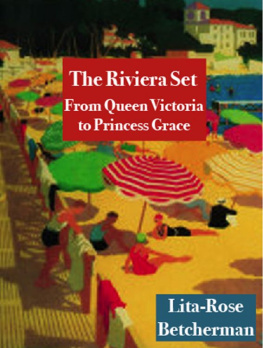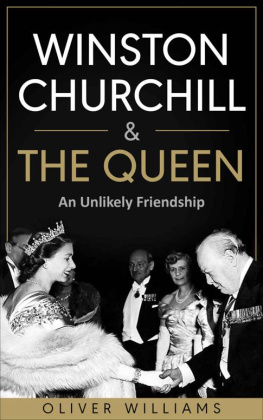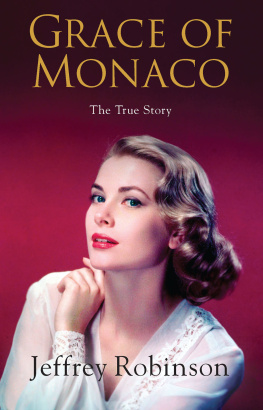Lita-Rose Betcherman - The Riviera Set: From Queen Victoria to Princess Grace
Here you can read online Lita-Rose Betcherman - The Riviera Set: From Queen Victoria to Princess Grace full text of the book (entire story) in english for free. Download pdf and epub, get meaning, cover and reviews about this ebook. year: 2011, publisher: Bev Editions, genre: History. Description of the work, (preface) as well as reviews are available. Best literature library LitArk.com created for fans of good reading and offers a wide selection of genres:
Romance novel
Science fiction
Adventure
Detective
Science
History
Home and family
Prose
Art
Politics
Computer
Non-fiction
Religion
Business
Children
Humor
Choose a favorite category and find really read worthwhile books. Enjoy immersion in the world of imagination, feel the emotions of the characters or learn something new for yourself, make an fascinating discovery.
- Book:The Riviera Set: From Queen Victoria to Princess Grace
- Author:
- Publisher:Bev Editions
- Genre:
- Year:2011
- Rating:3 / 5
- Favourites:Add to favourites
- Your mark:
- 60
- 1
- 2
- 3
- 4
- 5
The Riviera Set: From Queen Victoria to Princess Grace: summary, description and annotation
We offer to read an annotation, description, summary or preface (depends on what the author of the book "The Riviera Set: From Queen Victoria to Princess Grace" wrote himself). If you haven't found the necessary information about the book — write in the comments, we will try to find it.
The Riviera Set: From Queen Victoria to Princess Grace — read online for free the complete book (whole text) full work
Below is the text of the book, divided by pages. System saving the place of the last page read, allows you to conveniently read the book "The Riviera Set: From Queen Victoria to Princess Grace" online for free, without having to search again every time where you left off. Put a bookmark, and you can go to the page where you finished reading at any time.
Font size:
Interval:
Bookmark:
THE RIVIERA SET
By Lita-Rose Betcherman
Author of the acclaimed Court Lady andCountry Wife
Published by Bev Editions at Smashwords
ISBN: 978-0-9867287-4-7
Copyright 2010 Lita-Rose Betcherman
Smashwords Edition, License Notes
This ebook is licensed for your personalenjoyment only. This ebook may not be re-sold or given away toother people. If you would like to share this book with anotherperson, please purchase an additional copy for each person. Ifyou're reading this book and did not purchase it, or it was notpurchased for your use only, then please return to Smashwords.comand purchase your own copy. Thank you for respecting the hard workof this author.
Table of Contents
Amanda: Whose yacht is that?
Elyot: The Duke of Westminsters I expect, italways is.
Amanda and Elyot are standing on a hotelbalcony overlooking the sea. From their clothes it is clearly theperiod between the two World Wars. The sophisticated dialogue,spoken with a clipped English accent, identifies them as members ofthe Mayfair Set -- upper-class Britons who lived in Londons WestEnd and in country houses when they were not travelling abroad.
In 1929, when Noel Coward wrote this scenefrom "Private Lives," the Mayfair Set was flocking to the South ofFrance. Leafing through old copies of The Illustrated LondonNews or British Vogue, it seems that everyone who wasanyone went to the Riviera and nearly everyone had a yacht (thoughnot two yachts like the Duke of Westminster). This is only oneslice of the upper crust that has holidayed on the Riviera. Beforethe First World War, the Rivieras guest list read like Debrettsand the Almanach de Gotha combined. After the Second World War, theJet Set of oil millionaires, ex-kings, and stars of theentertainment world appropriated this earthly paradise.
And not only High Society but the artisticworld too. The School of Paris drew so much inspiration from theMediterranean light and color that it might just as well be calledthe Riviera School. Indeed, the window views of Matisse and Dufyencapsulate the regions physical charms. The Riviera has drawnlegions of writers to its shores. We think of Prosper Merimeenursing his asthma at Cannes, Guy de Maupassant restlessly cruisingthe coast in the Bel Ami, Arnold Bennett at the palace hotels, H.G.Wells in a love nest at Grasse. The list is endless: Hemingway,Fitzgerald, Somerset Maugham, Katherine Mansfield, D.H. Lawrence,Cyril Connolly, Graham Green, and on to Irwin Shaw and HaroldRobbins. Appropriately, Noel Coward and Gertrude Lawrence - thefirst Amanda and Elyot - rehearsed some of Private Lives at a CapdAil villa.
Riviera, Cote dAzur, South of France, or leMidi as the French call it, by whatever name the Mediterraneancoast between Saint-Tropez and Menton evokes images of glamorouspeople enjoying the sweetness of life against a stunning backdropof palms, gleaming white villas, yachts, and the blueMediterranean.
But that was not how it began.
In the nineteenth century, to go to theRiviera in the summer was thought to invite death from heatprostration or malaria. Originally, it was nothing more than awinter sanitarium for consumptives. Alexander Dumas, pere, whoseson created the most famous consumptive of all in La Dame auxCamelias, observed in 1847 that frail pale women come to Nice todie, and he criticized the townsfolk for living at the expense ofthe sick foreigners. At mid-century, the French had not yetdiscovered the charms of their sun-drenched Mediterranean coast. Itwas the British invalid who pioneered the discovery of the mostfamous resort area in the history of travel. These ailingnortherners were the first Riviera Set.
In the 1850s, British consumptives in searchof winter sun had an arduous journey before them. They could go toEgypt above the cataracts where the climate was hot and dry, butthat meant a grueling eight days by sea and then a slow houseboatup the Nile. It was not unknown for sufferers to go to Algiers, andsome of the more adventurous sailed as far as the Cape of Good Hopein South Africa. The island of Madeira had a small English wintercolony. However, the usual destination of British travellers, bothailing and healthy, was Italy. The well-known London hostess, LadyHolland, had wintered at Naples for years, simply transferring hersalon to a palazzo overlooking the famous bay. Florence and Venicewere long-established winter resorts, particularly for art lovers,in spite of damp, dreary weather that was barely an improvementover London. Nice, a provincial capital in the kingdom of Sardinia,offered better weather and a shorter journey -- British invalids,as well as Russians and other Europeans, had been wintering therefor a century. However by the middle of the nineteenth century,Cannes, a small French port not far from Nice, was hosting a wintercolony of upper-class Britons.
Cannes history as a resort began when aretired English statesman, Lord Henry Brougham, discovered thearea. In the winter of 1834, en route to Nice with a consumptivedaughter, the former Lord Chancellor found the weather at thelittle fishing village of Cannes as mild as Cairo and decided togo no further. On an uninhabited hillside covered with pine treesand an orange grove, he built a colonnaded Regency mansion that henamed the Villa Eleonora after his daughter who died before it wascompleted. Other titled Britons followed the old lord and by themid-1850s there were some forty or fifty families winteringthere.
In Letters from Cannes and Nice (1857)Margaret Brewster, a genteel Scottish spinster with the observanteye of a Jane Austen, described Cannes society of themid-nineteenth century as simple and kindly, without formality oroverdressing. Like Margaret, many winter residents suffered fromconsumption, and the daily routine was a morning walk by the sea,the ladies sheltering from the sun under white parasols, thickveils, and wide-brimmed hats lined with white paper, afternoons inthe garden, and early-to-bed evenings. Entertainment at the villasconsisted of reading and discussing a portion of Scripture. Canneswas so prim and proper that Prosper Merimee, the author of Carmenand other naughty tales, was prompted to say that only the frogsand crickets are eager to make love here. Until his death in 1868Lord Brougham, as Cannes founder, was the leader of this ailingand very moral society of Victorians abroad.
While the English were lording it at Cannesthe Russians were the dominant foreigners at Nice. The visits oftwo tsarinas in the 1850s and 1860s brought a shoal of grand dukesand imperial officials in their wake. These in turn were followedby wealthy Russians who squandered the rents from their estates onEuropean travel.
Tourism on the Riviera began in earnest withthe coming of the railway in the 1860s. The Franco-Prussian War of1870 that led to the deposing of Napoleon III and the establishmentof a republic in France only temporarily slowed the tourist trade.The railway, coupled with the opening of Monte Carlo the elegantgambling casino at Monaco transformed Nice from a sanitarium forsickly northerners into a pleasure resort like Baden-Baden andBiarritz.
While Nice with its boulevards, clubs,theatres, and brilliantly lighted cafes hospitably received thenew middle class, by the 1880s Cannes had taken on all thesnobbishness and exclusivity of a London club. Attracted by allthings British the European elite made Cannes its winterheadquarters, arriving by yacht, private railway carriage, and thedeluxe Mediterranean Express newly equipped with sleeping cars.
The illustrious traveller who, more than anyother, created the vogue for the Winter Riviera was QueenVictorias son and heir, Edward Albert, Prince of Wales.
The Prince of Wales, King of the Riviera
The Prince of Wales, later King Edward VII,came to Cannes every winter for three weeks, timing his stay forthe Battle of the Flowers at Nice - a feature of the pre-Lentencarnival. Precluded from the English throne and from all affairs ofstate by his eternal mother, the middle-aged Prince of Wales wasindisputably King of the Riviera. Gregarious and charming, he wasthe style-setter for his generation. Men of all nationalitiescopied his tailoring and his barbering. When he accommodated hiscorpulent stomach by leaving his waistcoat partially unbuttoned,this became the fashion. When he adopted the felt hat made in thevicinity of his favourite spa, the Homburg was born. Looking at oldphotographs of high society gives the impression that all the maleswere cloned from the Prince. His annual visit set the fashion forwintering at Cannes.
Next pageFont size:
Interval:
Bookmark:
Similar books «The Riviera Set: From Queen Victoria to Princess Grace»
Look at similar books to The Riviera Set: From Queen Victoria to Princess Grace. We have selected literature similar in name and meaning in the hope of providing readers with more options to find new, interesting, not yet read works.
Discussion, reviews of the book The Riviera Set: From Queen Victoria to Princess Grace and just readers' own opinions. Leave your comments, write what you think about the work, its meaning or the main characters. Specify what exactly you liked and what you didn't like, and why you think so.











